Обработка ошибок в VBA Excel с помощью оператора On Error. Синтаксис выражений с оператором On Error. Пример кода с простым обработчиком ошибок.
On Error – это оператор, который используется для отслеживания ошибок во время исполнения кода VBA. При возникновении ошибки On Error передает информацию о ней в объект Err и включает программу обработки ошибок, начинающуюся с указанной строки.
В первую очередь, обработчик ошибок нужен для пользователей файлов Excel с кодами VBA. Любая ошибка приводит к прекращению выполнения программы, открытию редактора VBA с непонятным для пользователя сообщением или даже к полному зависанию приложения.
Обработчик ошибок позволяет завершить выполнение программы при возникновении ошибки и вывести сообщение пользователю с ее описанием.
Синтаксис выражений с On Error
Включает алгоритм обнаружения ошибок и, в случае возникновения ошибки, передает управление операторам обработчика ошибок с указанной в выражении строки. Stroka – это метка, после которой расположены операторы обработчика ошибок.
Включает алгоритм обнаружения ошибок и, в случае возникновения ошибки, передает управление оператору, следующему за оператором, вызвавшем ошибку.
Отключает любой включенный обработчик ошибок в текущей процедуре.
Простой обработчик ошибок
Шаблон простейшего обработчика ошибок:
|
Sub Primer() On Error GoTo Stroka ‘Блок операторов процедуры Exit Sub Stroka: MsgBox «Произошла ошибка: « & Err.Description End Sub |
Оператор On Error GoTo размещается в начале процедуры, метка и обработчик ошибок – в конце процедуры. Название метки можно сменить на другое, в том числе на кириллице.
Оператор Exit Sub обеспечивает выход из процедуры, если блок операторов выполнен без ошибок. Для вывода описания ошибки используется свойство Description объекта Err.
Примеры обработки ошибок
Пример 1
Деление на ноль:
|
Sub Primer1() On Error GoTo Инструкция Dim a As Double a = 45 / 0 Exit Sub Instr: MsgBox «Произошла ошибка: « & Err.Description End Sub |
Результат выполнения кода VBA Excel с обработчиком ошибок:
Пример 2
Выход за границы диапазона:
|
Sub Primer2() On Error GoTo Instr Dim myRange As Range Set myRange = Range(«A1:D4»).Offset(—2) Exit Sub Instr: MsgBox «Произошла ошибка: « & Err.Description End Sub |
Результат выполнения кода VBA Excel с оператором On Error GoTo:
Пример использования выражений On Error Resume Next и On Error GoTo 0 смотрите в статье: Отбор уникальных значений с помощью Collection.
In this Article
- VBA Errors Cheat Sheet
- Errors
- VBA Error Handling
- VBA On Error Statement
- On Error GoTo 0
- On Error Resume Next
- Err.Number, Err.Clear, and Catching Errors
- On Error GoTo Line
- VBA IsError
- If Error VBA
- VBA Error Types
- Runtime Errors
- Syntax Errors
- Compile Errors
- Debug > Compile
- OverFlow Error
- Other VBA Error Terms
- VBA Catch Error
- VBA Ignore Error
- VBA Throw Error / Err.Raise
- VBA Error Trapping
- VBA Error Message
- VBA Error Handling in a Loop
- VBA Error Handling in Access
VBA Errors Cheat Sheet
Errors
On Error – Stop code and display error
On Error Goto 0
On Error – Skip error and continue running
On Error Resume Next
On Error – Go to a line of code [Label]
On Error Goto [Label]
Clears (Resets) Error
On Error GoTo –1
Show Error number
MsgBox Err.Number
Show Description of error
MsgBox Err.Description
Function to generate own error
Err.Raise
See more VBA “Cheat Sheets” and free PDF Downloads
VBA Error Handling
VBA Error Handling refers to the process of anticipating, detecting, and resolving VBA Runtime Errors. The VBA Error Handling process occurs when writing code, before any errors actually occur.
VBA Runtime Errors are errors that occur during code execution. Examples of runtime errors include:
- Referencing a non-existent workbook, worksheet, or other object (Run-time Error 1004)
- Invalid data ex. referencing an Excel cell containing an error (Type Mismatch – Run-time Error 13)
- Attempting to divide by zero
VBA On Error Statement
Most VBA error handling is done with the On Error Statement. The On Error statement tells VBA what to do if it encounters an error. There are three On Error Statements:
- On Error GoTo 0
- On Error Resume Next
- On Error GoTo Line
On Error GoTo 0
On Error GoTo 0 is VBA’s default setting. You can restore this default setting by adding the following line of code:
On Error GoTo 0When an error occurs with On Error GoTo 0, VBA will stop executing code and display its standard error message box.
Often you will add an On Error GoTo 0 after adding On Error Resume Next error handling (next section):
Sub ErrorGoTo0()
On Error Resume Next
ActiveSheet.Shapes("Start_Button").Delete
On Error GoTo 0
'Run More Code
End SubOn Error Resume Next
On Error Resume Next tells VBA to skip any lines of code containing errors and proceed to the next line.
On Error Resume NextNote: On Error Resume Next does not fix an error, or otherwise resolve it. It simply tells VBA to proceed as if the line of code containing the error did not exist. Improper use of On Error Resume Next can result in unintended consequences.
A great time to use On Error Resume Next is when working with objects that may or may not exist. For example, you want to write some code that will delete a shape, but if you run the code when the shape is already deleted, VBA will throw an error. Instead you can use On Error Resume Next to tell VBA to delete the shape if it exists.
On Error Resume Next
ActiveSheet.Shapes("Start_Button").Delete
On Error GoTo 0Notice we added On Error GoTo 0 after the line of code containing the potential error. This resets the error handling.
In the next section we’ll show you how to test if an error occurred using Err.Number, giving you more advanced error handling options.
VBA Coding Made Easy
Stop searching for VBA code online. Learn more about AutoMacro — A VBA Code Builder that allows beginners to code procedures from scratch with minimal coding knowledge and with many time-saving features for all users!
Learn More
Err.Number, Err.Clear, and Catching Errors
Instead of simply skipping over a line containing an error, we can catch the error by using On Error Resume Next and Err.Number.
Err.Number returns an error number corresponding with the type of error detected. If there is no error, Err.Number = 0.
For example, this procedure will return “11” because the error that occurs is Run-time error ’11’.
Sub ErrorNumber_ex()
On Error Resume Next
ActiveCell.Value = 2 / 0
MsgBox Err.Number
End SubError Handling with Err.Number
The true power of Err.Number lies in the ability to detect if an error occurred (Err.Number <> 0). In the example below, we’ve created a function that will test if a sheet exists by using Err.Number.
Sub TestWS()
MsgBox DoesWSExist("test")
End Sub
Function DoesWSExist(wsName As String) As Boolean
Dim ws As Worksheet
On Error Resume Next
Set ws = Sheets(wsName)
'If Error WS Does not exist
If Err.Number <> 0 Then
DoesWSExist = False
Else
DoesWSExist = True
End If
On Error GoTo -1
End FunctionNote: We’ve added a On Error GoTo -1 to the end which resets Err.Number to 0 (see two sections down).
With On Error Resume Next and Err.Number, you can replicate the “Try” & “Catch” functionality of other programming languages.
On Error GoTo Line
On Error GoTo Line tells VBA to “go to” a labeled line of code when an error is encountered. You declare the Go To statement like this (where errHandler is the line label to go to):
On Error GoTo errHandlerand create a line label like this:
errHandler:Note: This is the same label that you’d use with a regular VBA GoTo Statement.
Below we will demonstrate using On Error GoTo Line to Exit a procedure.
On Error Exit Sub
You can use On Error GoTo Line to exit a sub when an error occurs.
You can do this by placing the error handler line label at the end of your procedure:
Sub ErrGoToEnd()
On Error GoTo endProc
'Some Code
endProc:
End Subor by using the Exit Sub command:
Sub ErrGoToEnd()
On Error GoTo endProc
'Some Code
GoTo skipExit
endProc:
Exit Sub
skipExit:
'Some More Code
End SubErr.Clear, On Error GoTo -1, and Resetting Err.Number
After an error is handled, you should generally clear the error to prevent future issues with error handling.
After an error occurs, both Err.Clear and On Error GoTo -1 can be used to reset Err.Number to 0. But there is one very important difference: Err.Clear does not reset the actual error itself, it only resets the Err.Number.
What does that mean? Using Err.Clear, you will not be able to change the error handling setting. To see the difference, test out this code and replace On Error GoTo -1 with Err.Clear:
Sub ErrExamples()
On Error GoTo errHandler:
'"Application-defined" error
Error (13)
Exit Sub
errHandler:
' Clear Error
On Error GoTo -1
On Error GoTo errHandler2:
'"Type mismatch" error
Error (1034)
Exit Sub
errHandler2:
Debug.Print Err.Description
End SubTypically, I recommend always using On Error GoTo -1, unless you have a good reason to use Err.Clear instead.
VBA On Error MsgBox
You might also want to display a Message Box on error. This example will display different message boxes depending on where the error occurs:
Sub ErrorMessageEx()
Dim errMsg As String
On Error GoTo errHandler
'Stage 1
errMsg = "An error occured during the Copy & Paste stage."
'Err.Raise (11)
'Stage 2
errMsg = "An error occured during the Data Validation stage."
'Err.Raise (11)
'Stage 3
errMsg = "An error occured during the P&L-Building and Copy-Over stage."
Err.Raise (11)
'Stage 4
errMsg = "An error occured while attempting to log the Import on the Setup Page"
'Err.Raise (11)
GoTo endProc
errHandler:
MsgBox errMsg
endProc:
End SubHere you would replace Err.Raise(11) with your actual code.
VBA IsError
Another way to handle errors is to test for them with the VBA ISERROR Function. The ISERROR Function tests an expression for errors, returning TRUE or FALSE if an error occurs.
Sub IsErrorEx()
MsgBox IsError(Range("a7").Value)
End SubVBA Programming | Code Generator does work for you!
If Error VBA
You can also handle errors in VBA with the Excel IFERROR Function. The IFERROR Function must be accessed by using the WorksheetFunction Class:
Sub IfErrorEx()
Dim n As Long
n = WorksheetFunction.IfError(Range("a10").Value, 0)
MsgBox n
End SubThis will output the value of Range A10, if the value is an error, it will output 0 instead.
VBA Error Types
Runtime Errors
As stated above:
VBA Runtime Errors are errors that occur during code execution. Examples of runtime errors include:
- Referencing a non-existent workbook, worksheet, or other object
- Invalid data ex. referencing an Excel cell containing an error
- Attempting to divide by zero
You can “error handle” runtime errors using the methods discussed above.
Syntax Errors
VBA Syntax Errors are errors with code writing. Examples of syntax errors include:
- Mispelling
- Missing or incorrect punctuation
The VBA Editor identifies many syntax errors with red highlighting:
The VBA Editor also has an option to “Auto Syntax Check”:
When this is checked, the VBA Editor will generate a message box alerting you syntax errors after you enter a line of code:
I personally find this extremely annoying and disable the feature.
Compile Errors
Before attempting to run a procedure, VBA will “compile” the procedure. Compiling transforms the program from source code (that you can see) into executable form (you can’t see).
VBA Compile Errors are errors that prevent the code from compiling.
A good example of a compile error is a missing variable declaration:
Other examples include:
- For without Next
- Select without End Select
- If without End If
- Calling a procedure that does not exist
Syntax Errors (previous section) are a subset of Compile Errors.
AutoMacro | Ultimate VBA Add-in | Click for Free Trial!
Debug > Compile
Compile errors will appear when you attempt to run a Procedure. But ideally, you would identify compile errors prior to attempting to run the procedure.
You can do this by compiling the project ahead of time. To do so, go to Debug > Compile VBA Project.
The compiler will “go to” the first error. Once you fix that error, compile the project again. Repeat until all errors are fixed.
You can tell that all errors are fixed because Compile VBA Project will be grayed out:
OverFlow Error
The VBA OverFlow Error occurs when you attempt to put a value into a variable that is too large. For example, Integer Variables can only contain values between -32,768 to 32,768. If you enter a larger value, you’ll receive an Overflow error:
Instead, you should use the Long Variable to store the larger number.
Other VBA Error Terms
VBA Catch Error
Unlike other programming languages, In VBA there is no Catch Statement. However, you can replicate a Catch Statement by using On Error Resume Next and If Err.Number <> 0 Then. This is covered above in Error Handling with Err.Number.
AutoMacro | Ultimate VBA Add-in | Click for Free Trial!
VBA Ignore Error
To ignore errors in VBA, simply use the On Error Resume Next statement:
On Error Resume NextHowever, as mentioned above, you should be careful using this statement as it doesn’t fix an error, it just simply ignores the line of code containing the error.
VBA Throw Error / Err.Raise
To through an error in VBA, you use the Err.Raise method.
This line of code will raise Run-time error ’13’: Type mismatch:
Err.Raise (13)VBA Error Trapping
VBA Error Trapping is just another term for VBA Error Handling.
VBA Error Message
A VBA Error Message looks like this:
When you click ‘Debug’, you’ll see the line of code that is throwing the error:
AutoMacro | Ultimate VBA Add-in | Click for Free Trial!
VBA Error Handling in a Loop
The best way to error handle within a Loop is by using On Error Resume Next along with Err.Number to detect if an error has occurred (Remember to use Err.Clear to clear the error after each occurrence).
The example below will divide two numbers (Column A by Column B) and output the result into Column C. If there’s an error, the result will be 0.
Sub test()
Dim cell As Range
On Error Resume Next
For Each cell In Range("a1:a10")
'Set Cell Value
cell.Offset(0, 2).Value = cell.Value / cell.Offset(0, 1).Value
'If Cell.Value is Error then Default to 0
If Err.Number <> 0 Then
cell.Offset(0, 2).Value = 0
Err.Clear
End If
Next
End SubVBA Error Handling in Access
All of the above examples work exactly the same in Access VBA as in Excel VBA.
Function DelRecord(frm As Form)
'this function is used to delete a record in a table from a form
On Error GoTo ending
With frm
If .NewRecord Then
.Undo
Exit Function
End If
End With
With frm.RecordsetClone
.Bookmark = frm.Bookmark
.Delete
frm.Requery
End With
Exit Function
ending:
End
End Function
Error handling refers to the way runtime errors are handled. Error handling in VBA is done using the On Error statement and the Err object. Runtime errors can be generated by attempting to execute error-causing code or they can be raised explicitly using the Err.Raise method. There are a number of built-in types of runtime errors, and custom errors can be defined as well. Each type of runtime error has a unique number which can be used to determine at runtime which type of error has occurred and respond accordingly.
On Error
The On Error statement is used to control what happens when a runtime error occurs. The On Error statement sets or removes the current error handling scope. When a runtime error occurs in VBA the error trap is triggered and if an On Error statement has been set, VBA will respond according to which type of On Error statement was used.
| Statement | Description |
|---|---|
| On Error Resume Next | Skips lines of code that cause errors. Use with caution. |
| On Error GoTo Line | When an error occurs execution will jump to a specified label or line number. |
| On Error GoTo 0 | Clears the current error and disables error handling. |
| On Error GoTo -1 | Clears the current error and resets the error trap. |
| Resume | When used after the On Error GoTo statement, Resume will continue execution from the line of code that caused the error. |
| Resume Next | When used after the On Error GoTo statement, Resume Next will continue execution from the line of code directly after the line that caused the error. |
| Resume Line | When used after the On Error GoTo statement, Resume Line will jump to a specified label or line number and continue execution. |
On Error Resume Next
Public Sub Example()
On Error Resume Next
Err.Raise 1004
Debug.Print "Error was skipped"
End SubOn Error GoTo Line
Public Sub Example()
On Error GoTo HandleError
Err.Raise 1004
Exit Sub
HandleError:
Debug.Print "Error Handled"
End SubNote: It is not recommended to use line numbers.
Public Sub Example()
10
20 On Error GoTo 80
30
40 Err.Raise 1004
50
60 Exit Sub
70
80 Debug.Print "Error Handled"
90
End SubOn Error GoTo…Resume
Public Sub Example()
Dim N As Long
N = 0
On Error GoTo HandleError
'Divide by zero error will be fixed by error handler
Debug.Print 1 / N
Debug.Print "Error Handled."
Exit Sub
HandleError:
If Err.Number = 11 Then
Debug.Print "Handling 'Division by zero' Error..."
N = 1
Resume
Else
Err.Raise Err.Number
End If
End SubOn Error GoTo…Resume Next
Public Sub Example()
On Error GoTo HandleError
Err.Raise 1004
Debug.Print "Error Handled. Resuming Next..."
Exit Sub
HandleError:
Debug.Print "Handling Error..."
Resume Next
End SubOn Error GoTo…Resume Line
Public Sub Example()
On Error GoTo HandleError
Err.Raise 1004
Continue:
Debug.Print "Resuming..."
Exit Sub
HandleError:
Debug.Print "Error Handled"
Resume Continue
End SubNote: It is not recommended to use line numbers.
Public Sub Example()
10
20 On Error GoTo 100
30
40 Err.Raise 1004
50
60 Debug.Print "Resuming..."
70
80 Exit Sub
90
100 Debug.Print "Error Handled"
110 Resume 60
120
End SubOn Error GoTo 0
Public Sub Example()
On Error Resume Next
Err.Raise 1004 'Error will be skipped
On Error GoTo 0
Err.Raise 1004 'Error will be raised
End SubOn Error GoTo -1
Public Sub Example()
On Error GoTo HandleError1
Err.Raise 1004
Exit Sub
HandleError1:
Debug.Print "HandleError1"
On Error GoTo -1
On Error GoTo HandleError2
Err.Raise 1004
Exit Sub
HandleError2:
Debug.Print "HandleError2"
Exit Sub
End SubThe Err Object
The Err Object is used to access information about a runtime error that has occurred. When a runtime error occurs, the Err object’s properties are filled with information about the error. The Err object can also be used to raise errors explicitly.
| Member | Description |
|---|---|
| Clear | Clears properties of the Err object. Does NOT reset error trap or clear error handling scope. |
| Description | A text description of the error. |
| HelpContext | The context ID for a topic in a help file. |
| HelpFile | The path to help file. |
| LastDllError | Returns a system error code produced by a call to a dynamic-link library (DLL). Read-only. Always returns zero on Mac. |
| Number | The error number, 0 through 65535. |
| Raise | Raises a specified runtime error. |
| Source | The name of the object or application that originated the error. |
The Err Object is a Singleton
The Err object has a single default global instance and cannot be instantiated. The Err object can be accessed anywhere in VBA just by typing Err.
Public Sub Example()
Err.Raise 1004 'No need to instantiate Err object
End SubPublic Sub Example()
Dim E As ErrObject
Set E = New ErrObject 'Causes error
End SubProperties
The Err object’s properties are filled with data when a runtime error occurs. The Number property is especially important because it can be used to dynamically respond to different types of errors. If no runtime error has occurred, the Number property will be 0. Therefore, to determine if an error has occurred in a particular line, the Number property can be checked to see if it is 0 or not.
Public Sub Example()
On Error Resume Next
Err.Raise 1004
If Err.Number <> 0 Then
With Err
Debug.Print "Number: " & .Number
Debug.Print "Description: " & .Description
Debug.Print "Source: " & .Source
Debug.Print "HelpFile: " & .HelpFile
Debug.Print "HelpContext: " & .HelpContext
Debug.Print "LastDllError: " & .LastDllError
End With
Err.Raise Err.Number
Else
Debug.Print "No Error"
End If
End SubClearing The Err Object
The Err object can be reset in a few different ways. The Err object is reset when Err.Clear is called, a Resume or Resume Next statement is executed for the error, or another On Error statement is executed. Exiting an error-causing procedure does not reset the Err object.
Note: Exiting an error-causing procedure does not reset the Err object.
Public Sub Example()
Call ErrorCausingProcedure1
Debug.Print Err.Number 'Prints 1004
Call ErrorCausingProcedure2
Debug.Print Err.Number 'Prints 0
Call ErrorCausingProcedure3
Debug.Print Err.Number 'Prints 0
Call ErrorCausingProcedure4
Debug.Print Err.Number 'Prints 0
End Sub
Public Sub ErrorCausingProcedure1()
'Exiting procedure doe NOT reset the Err object
On Error Resume Next
Err.Raise 1004
End Sub
Public Sub ErrorCausingProcedure2()
'Calling Err.Clear resets the Err object
On Error Resume Next
Err.Raise 1004
Err.Clear
End Sub
Public Sub ErrorCausingProcedure3()
'Resume Next resets the Err object
On Error GoTo HandleError
Err.Raise 1004
Exit Sub
HandleError:
Resume Next
End Sub
Public Sub ErrorCausingProcedure4()
'On Error statement resets the Err object
On Error Resume Next
Err.Raise 1004
On Error GoTo 0
End SubCalling Err.Clear only clears the Err object. Err.Clear does not reset the error handling trap or end the error handling scope. On Error GoTo -1 will clear the Err object and reset error trapping, allowing another error to be raised. On Error GoTo 0 will clear the Err object and clear the error handling scope.
Public Sub Example()
On Error Resume Next
'Error is skipped
Err.Raise 1004
'Prints 1004
Debug.Print Err.Number
'Err object is reset
Err.Clear
'Prints 0
Debug.Print Err.Number
'Error is skipped because error handling scope was not reset
Err.Raise 1004
'Prints 1004
Debug.Print Err.Number
'Clears Err object and error handling scope
On Error GoTo 0
'Prints 0
Debug.Print Err.Number
'Raises a runtime error
Err.Raise 1004
End SubError Trapping Options
Error Trapping options can be selected which can override error handling code in VBA. To change error trapping options navigate to Tools → Options → General in the Visual Basic Editor.
| Option | Description |
|---|---|
| Break on All Errors | Will enter break mode when any error is encountered regardless of error handling code. |
| Break in Class Module | Will enter break mode and show errors inside class modules. |
| Break on Unhandled Errors | This is the default setting. Will enter break mode when an error is encountered and it is not handled by code. |
CVErr Function
The CVErr function can be used to return an error from a function. CVErr returns a value of type Variant with subtype Error. Only variables of type Variant can be assigned a value using the CVErr function. CVErr can take any error number as an argument. CVErr can be used to return a cell error from a user-defined function that is intended for use in spreadsheets.
Option Explicit
Public Function ReturnValueError() As Variant
'Shows #VALUE Error in cell
ReturnValueError = CVErr(xlErrValue)
End Function| xlErr Constant | Cell Error |
|---|---|
| xlErrBlocked | #BLOCKED! |
| xlErrCalc | #CALC! |
| xlErrConnect | #CONNECT! |
| xlErrDiv0 | #DIV/0! |
| xlErrField | #FIELD! |
| xlErrGettingData | #GETTING_DATA |
| xlErrNA | #N/A |
| xlErrName | #NAME? |
| xlErrNull | #NULL! |
| xlErrNum | #NUM! |
| xlErrRef | #REF! |
| xlErrSpill | #SPILL! |
| xlErrUnknown | #UNKNOWN! |
| xlErrValue | #VALUE! |
IsError Function
The IsError function returns True if the argument expression evaluates to an error. IsError can be used to test if a cell value contains an error or a user-defined function returns an error. To return an error from a function use the CVErr function.
Option Explicit
Public Sub Example()
If IsError(Range("A1").Value) Then
Debug.Print "Range A1 contains an error."
End If
Dim E As Variant
E = ReturnError()
If IsError(E) Then
Debug.Print "E is Error: " & CStr(E)
End If
End Sub
Public Function ReturnError() As Variant
ReturnError = CVErr(xlErrValue)
End FunctionError Function
The Error/Error$ function is used to return the description text of an error. The Error function can be used to return a specific error description based on an error number or it can return the description text of the last error to occur.
Specific Error Description
Pass the optional ErrorNumber argument to the Error function to return a specific error description. Although the Error function can take a number between -2147483648 and 65535, it should be intended for use with the range 0 through 65535. If the error number is outside the valid range an Overflow runtime error will occur. If the error number is within the valid range but is not defined, the message «Application-defined or object-defined error» will be returned.
Public Sub Example()
Debug.Print Error(5) 'Prints: Invalid procedure call or argument
End SubMost Recent Error Description
Call the Error function with no ErrorNumber argument to return the description text for the last error to occur. If no error has occurred, a zero-length string will be returned. The Err.Description property can be used to get the text description of the most recent runtime error instead of using the Error function.
Public Sub Example()
On Error Resume Next
Err.Raise 5
Debug.Print Error() 'Prints: Invalid procedure call or argument
End SubRaising Errors
Use the Err.Raise method to raise a runtime error. Errors should be raised when an unacceptable state has been reached in a program. Existing VBA error numbers can be used to raise errors or custom error numbers can be created.
Raising Existing Errors
An appropriate VBA error number can be selected which describes the error.
Public Function RandomLong(MinValue As Long, MaxValue As Long) As Long
If MinValue > MaxValue Then
Err.Raise 5
End If
Randomize
RandomLong = Int((MaxValue - MinValue + 1) * Rnd + MinValue)
End FunctionUser-Defined Errors
To raise a user-defined error, create an error number by using the vbObjectError constant and adding a number between 513 and 65535. The range 0 through 512 is reserved for system errors. The vbObjectError constant has the value -2147221504 so user-defined errors will be negative. To derive the positive portion of a user-defined error simply subtract the vbObjectError constant from the error number.
Public Sub Example()
On Error GoTo HandleError
Err.Raise Number:=vbObjectError + 513, Description:="Custom Error"
Exit Sub
HandleError:
Debug.Print Err.Number - vbObjectError, Err.Description 'Prints: 513 Custom Error
Resume Next
End SubError Statement
The Error statement raises a runtime error for a given error number. The Error statement is included for backward compatibility with older versions of VBA and Err.Raise should be used instead for new code.
Public Sub Example()
'Backward compatible
Error 5
'Use this for new code
Err.Raise 5
End SubError Numbers
Runtime errors each have a number used to identify what type of error it is. Error numbers can be used with the Err.Raise method, the Error statement, and the Error function. When a runtime error occurs, the Err.Number property will be set to the number associated with the type of error. Any positive error number not listed in the table below returns «Application-defined or object-defined error».
| Error Number | Error Text |
|---|---|
| 3 | Return without GoSub |
| 5 | Invalid procedure call or argument |
| 6 | Overflow |
| 7 | Out of memory |
| 9 | Subscript out of range |
| 10 | This array is fixed or temporarily locked |
| 11 | Division by zero |
| 13 | Type mismatch |
| 14 | Out of string space |
| 16 | Expression too complex |
| 17 | Can’t perform requested operation |
| 18 | User interrupt occurred |
| 20 | Resume without error |
| 28 | Out of stack space |
| 35 | Sub or Function not defined |
| 47 | Too many DLL application clients |
| 48 | Error in loading DLL |
| 49 | Bad DLL calling convention |
| 51 | Internal error |
| 52 | Bad file name or number |
| 53 | File not found |
| 54 | Bad file mode |
| 55 | File already open |
| 57 | Device I/O error |
| 58 | File already exists |
| 59 | Bad record length |
| 61 | Disk full |
| 62 | Input past end of file |
| 63 | Bad record number |
| 67 | Too many files |
| 68 | Device unavailable |
| 70 | Permission denied |
| 71 | Disk not ready |
| 74 | Can’t rename with different drive |
| 75 | Path/File access error |
| 76 | Path not found |
| 91 | Object variable or With block variable not set |
| 92 | For loop not initialized |
| 93 | Invalid pattern string |
| 94 | Invalid use of Null |
| 96 | Unable to sink events of object because the object is already firing events to the maximum number of event receivers that it supports |
| 97 | Can not call friend function on object which is not an instance of defining class |
| 98 | A property or method call cannot include a reference to a private object, either as an argument or as a return value |
| 321 (1 — 2) | Invalid file format |
| 322 | Can’t create necessary temporary file |
| 325 | Invalid format in resource file |
| 380 (1 — 2) | Invalid property value |
| 381 | Invalid property array index |
| 382 | Set not supported at runtime |
| 383 | Set not supported (read-only property) |
| 385 | Need property array index |
| 387 | Set not permitted |
| 393 | Get not supported at runtime |
| 394 | Get not supported (write-only property) |
| 422 | Property not found |
| 423 | Property or method not found |
| 424 | Object required |
| 429 | ActiveX component can’t create object |
| 430 | Class does not support Automation or does not support expected interface |
| 432 | File name or class name not found during Automation operation |
| 438 | Object doesn’t support this property or method |
| 440 | Automation error |
| 442 | Connection to type library or object library for remote process has been lost. Press OK for dialog to remove reference. |
| 443 | Automation object does not have a default value |
| 445 | Object doesn’t support this action |
| 446 | Object doesn’t support named arguments |
| 447 | Object doesn’t support current locale setting |
| 448 | Named argument not found |
| 449 | Argument not optional |
| 450 | Wrong number of arguments or invalid property assignment |
| 451 | Property let procedure not defined and property get procedure did not return an object |
| 452 | Invalid ordinal |
| 453 | Specified DLL function not found |
| 454 | Code resource not found |
| 455 | Code resource lock error |
| 457 | This key is already associated with an element of this collection |
| 458 | Variable uses an Automation type not supported in Visual Basic |
| 459 | Object or class does not support the set of events |
| 460 (1 — 2) | Invalid clipboard format |
| 461 | Method or data member not found |
| 462 | The remote server machine does not exist or is unavailable |
| 463 | Class not registered on local machine |
| 481 (1 — 2) | Invalid picture |
| 482 (1 — 2) | Printer error |
| 735 | Can’t save file to TEMP |
| 744 | Search text not found |
| 746 | Replacements too long |
| 1004 | Application-defined or object-defined error |
| 31001 | Application-defined or object-defined error. *Out of memory |
| 31004 | Application-defined or object-defined error. *No object |
| 31018 | Application-defined or object-defined error. *Class is not set |
| 31027 | Application-defined or object-defined error. *Unable to activate object |
| 31032 | Application-defined or object-defined error. *Unable to create embedded object |
| 31036 | Application-defined or object-defined error. *Error saving to file |
| 31037 | Application-defined or object-defined error. *Error loading from file |
|
Framed Пользователь Сообщений: 223 |
#1 04.03.2019 19:39:20 Коллеги, приветствую, Немного запутался в теме про обработчик ошибок, хотя, скорее всего, я нашёл ответ на вопрос в этой теме , просто не могу его понять до конца. Необходимо, чтобы в случае ошибки, которая возникает в определенный момент в коде, часть кода пропускалась, появлялся MsgBox с определенным текстом, после чего макрос продолжал бы работать в нормальном режиме (если будет какая-нибудь другая ошибка далее — выскочит диалоговое окно). Знаю, что задача простая, ну вот туплю что-то…
На данный момент все как надо, только вот когда даже ошибки нет вылезает MsgBox. Заранее спасибо. P.S. Как-то криво написал название темы, должна была быть VBA: Обработчик ошибок, пропуск кода и продолжение выполнения макроса. Изменено: Framed — 05.03.2019 00:54:10 |
||
|
Anchoret Пользователь Сообщений: 1065 Anchoret |
#2 04.03.2019 19:44:33
|
||
|
Framed Пользователь Сообщений: 223 |
#3 04.03.2019 19:52:06 Anchoret, вот так?
|
||
|
Sanja Пользователь Сообщений: 14850 |
#4 04.03.2019 19:54:37
Обработчик ошибок поместите в самый конец кода, а перед ним должна быть строка Exit Sub
Согласие есть продукт при полном непротивлении сторон. |
||||
|
Framed Пользователь Сообщений: 223 |
#5 04.03.2019 20:03:30 Sanja, спасибо, но разве Exit Sub не остановит выполнение всего макроса, если ошибки не будет? Я уточню, а то мне кажется, я плохо объяснил в шапке.
Выполняется макрос, и вот на 5 строке может выскочить ошибка, например, если файла нет, или его имя неверное. Мне нужно, чтобы в этом случае, часть кода 5-13 строка игнорировалась, не выполнялась и выскочил бы MsgBox c текстом, например, «Нет файла или имя некорректно». Далее код, который идет после ErrorHandler должен выполняться в обычном режиме (обычный режим для меня — это когда дальнейшие ошибки не вернут меня к ErrorHandler, простите за убогое объяснение). В случае же, если ошибки на 5 строке моего примера не возникнет — код работает в штатном режиме. Изменено: Framed — 04.03.2019 20:03:53 |
||
|
Anchoret Пользователь Сообщений: 1065 Anchoret |
#6 04.03.2019 20:06:40 Framed,
перед строкой, в которой вероятна ошибка
после такой строки. Ну и замечание от Sanja, |
||||
|
Framed Пользователь Сообщений: 223 |
Как-то не выходит. Дальнейшие ошибки в коде игнорируются, MsgBox вылезает, даже если ошибки не произошло. |
|
БМВ Модератор Сообщений: 21657 Excel 2013, 2016 |
#8 04.03.2019 20:25:02 только наверно так
По вопросам из тем форума, личку не читаю. |
||
|
Framed Пользователь Сообщений: 223 |
БМВ, спасибо, все отлично, только теперь в случае ошибки ниже End If, VBA продолжит выполнение кода, даже если, к примеру, название листа out of range и так далее. |
|
БМВ Модератор Сообщений: 21657 Excel 2013, 2016 |
Framed, я не зря там написал ‘ или on error goto 0 Изменено: БМВ — 04.03.2019 20:49:50 По вопросам из тем форума, личку не читаю. |
|
Framed Пользователь Сообщений: 223 |
#11 04.03.2019 20:52:16 БМВ, простите, я проглядел. Спасибо большое за помощь, теперь я понял больше, без вас не разобрался бы.
Я где-то читал, что метки не приветствуются в VBA. Да и мне привычнее с операторами условия |
||
|
БМВ Модератор Сообщений: 21657 Excel 2013, 2016 |
По вопросам из тем форума, личку не читаю. |
|
vikttur Пользователь Сообщений: 47199 |
#13 05.03.2019 00:23:09
Метки не беда, если не злоупотреблять и если они не нарушаюют ( не сильно нарушают ) структуру кода |
||
|
Nordheim Пользователь Сообщений: 3154 |
Причина ошибки в данном куске кода в чем заключается? «Все гениальное просто, а все простое гениально!!!» |
|
Framed Пользователь Сообщений: 223 |
Nordheim, потенциально ошибка в том, что файл с таким названием может отсутствовать на рабочем столе у юзера. Этот файл (если он есть) в моем коде открывается, оттуда ВПР-ом подтягивается информация, после чего он закрывается. Если такого файла нет — мне нужно было, чтобы: 1. Выводилось сообщение со специальным текстом, т.е. MsgBox; Вообще, мне помогли и тему можно было закрывать, но раз уж вы спросили БМВ, да, и я даже прочитал это несколько раз перед тем, как создать тему. Просто, откровенно говоря, не доходило до меня, как это правильно использовать; примеры из гугла не добавили ясности. Одним словом, еще учиться и учиться. Изменено: Framed — 05.03.2019 14:33:07 |
|
Nordheim Пользователь Сообщений: 3154 |
#16 05.03.2019 14:45:40
А если так:
Никакого On Error PS:
в отчетах. Изменено: Nordheim — 05.03.2019 14:48:24 «Все гениальное просто, а все простое гениально!!!» |
||||
|
Jack Famous Пользователь Сообщений: 11082 OS: Win 8.1 Корп. x64 | Excel 2016 x64: | Browser: Chrome |
#17 05.03.2019 15:02:02 Framed, очень много чего вам посоветовали — лень читать всё)) ссылка на тему с холиваром))) Итак, в чём проблема… Всё просто — код доходит до строки ErrorHandler: MsgBox «Произошла ошибка» и выводит сообщение об ошибке (как и должен). Чтобы этого избежать, я обычно делаю, как в #4 (Sanja), но можно и «в лоб» обойти:
— в таком случае, если мы дошли до GoTo nx, то просто «перепрыгиваем» ErrorHandler на метку nx. Если же произойдёт ошибка, то макрос «перепрыгнет» уже к метке ErrorHandler, минуя GoTo nx. P.S.: скорее всего, в вашем случае никакого On Error GoTo ErrorHandler не нужно — это подтверждает и наличие примеров, где легко без него можно обойтись. Я использую метки в основном, если нужно вернуться «выше по коду» (повтор ввода информации пользователем в случае ошибки) или, как уже сказал, чтобы избежать «ветвления» (многоуровневых вложенных «If—Else—End If»). Изменено: Jack Famous — 05.03.2019 15:34:40 Во всех делах очень полезно периодически ставить знак вопроса к тому, что вы с давних пор считали не требующим доказательств (Бертран Рассел) ►Благодарности сюда◄ |
||
|
БМВ Модератор Сообщений: 21657 Excel 2013, 2016 |
#18 05.03.2019 15:21:22 Nordheim,
Короче, при полном пути более 260 символов, файл есть, он виден, но открыть его не возможно, впрочем как и скопировать или удалить, понятно что лучше в этом случае обработать длину пути, но порой проще просто обратится и обработать ошибку. Но в целом я полностью согласен, что обрабатывать ошибку надо там, где избежать её не возможно другими методами. Jack Famous, так как я родом из VBS, а там нет Resume, то перешел на метку по ошибке, обратно не вернешься, что означает не продолжить с того же места. а это означает или куча меток и отдельные обработчики для каждой ошибки или ….. По вопросам из тем форума, личку не читаю. |
||
|
Jack Famous Пользователь Сообщений: 11082 OS: Win 8.1 Корп. x64 | Excel 2016 x64: | Browser: Chrome |
#19 05.03.2019 15:32:09
а я, стало быть, из VBA и могу использовать крутые штуки типа возврата наверх))
Во всех делах очень полезно периодически ставить знак вопроса к тому, что вы с давних пор считали не требующим доказательств (Бертран Рассел) ►Благодарности сюда◄ |
|||
|
Nordheim Пользователь Сообщений: 3154 |
#20 05.03.2019 15:32:29 БМВ, На сколько я понимаю в данном случае путь прописывается руками, и визуально видно сколько символов.
Не сталкивался, потому наверное, что c Excel работаю постольку поскольку, это больше для саморазвития (интересные задания иногда встречаются). «Все гениальное просто, а все простое гениально!!!» |
||
|
БМВ Модератор Сообщений: 21657 Excel 2013, 2016 |
#21 05.03.2019 16:15:03
да все верно, ремарка относилась скорее к тому, что бывает, когда невозможно отсечь возможность возникновения ошибки заранее. По вопросам из тем форума, личку не читаю. |
||
|
Казанский Пользователь Сообщений: 8839 |
#22 05.03.2019 16:56:51
Забыл, забыл ты свою родину |
||
|
Framed Пользователь Сообщений: 223 |
Jack Famous, спасибо за разъяснения; Все-таки поясню: планируется, что файл, наличие которого проверяется, я буду высылать юзерам ежемесячно. У него относительно постоянная форма, меняются лишь данные. Соответственно, название файлу задаю тоже я. Файл носит вспомогательный характер. Вряд ли юзеры будут его переименовывать (я обязательно скажу, чтобы этого не делали) — их задача состоит лишь в том, чтобы один раз скопировать этот файл из Аутлука и куда-нибудь его закинуть, а после прописать корректный путь в VBA (а вот это им придется делать в любом случае самим, увы). |
|
БМВ Модератор Сообщений: 21657 Excel 2013, 2016 |
#24 05.03.2019 18:47:08
По вопросам из тем форума, личку не читаю. |
||
|
Nordheim Пользователь Сообщений: 3154 |
#25 05.03.2019 19:11:54
А если написать юзерам что бы сохранили файл с макросом и файл из которого берутся данные, в одну папку, то и прописывать ничего не нужно. Как вариант, можно сделать выбор файла. «Все гениальное просто, а все простое гениально!!!» |
||
|
RAN Пользователь Сообщений: 7155 |
#26 05.03.2019 19:48:22
Еще короче. Для Exsel, кажется, 218 символов. Попадал. |
||
|
БМВ Модератор Сообщений: 21657 Excel 2013, 2016 |
#27 06.03.2019 08:03:50 Off
Это не совсем про файл, а скорее про обращение к нему из самого Excel https://support.microsoft.com/en-us/help/213983/error-message-when-you-open-or-save-a-file-in-microsoft-excel-filename This behavior is based on a 256-character limitation in Excel for creating links to another file. This limit of 218 characters for the path name is based on the following:•Up to 31 characters in a sheet name. •Apostrophes and brackets used to denote the workbook name. •An exclamation point. •A cell reference. For example, the path for a file might resemple the following: ‘c:excelpersonal…[my workbook.xls]up_to_31_char_sheetname’!$A$1 Если перевести кратко, то, для работы с другой книгой, ссылка не может быть больше 256 символов, включая дополнительные символы (скобки,апострофы, восклицательный знак), имя листа и диапазон. если учесть что Адрес может быть $AAA$1000000 (12 сим) +31 на имя листа + 5 на спец символы, то на путь останется менее 218ти По вопросам из тем форума, личку не читаю. |
||
|
Nordheim Пользователь Сообщений: 3154 |
#28 06.03.2019 08:54:26 В дополнении
Вариант файла с макросом при открытии запрашивает папку для сохранения, затем сохраняет текущую книгу в указанную папку, и удаляет модуль с процедурой сохранения. Прикрепленные файлы
«Все гениальное просто, а все простое гениально!!!» |
||
|
Framed Пользователь Сообщений: 223 |
#29 13.03.2019 17:36:49 Коллеги, прошу прощения заранее, что поднимаю старую тему и задаю в ней вопрос, но он связан с тем же макросом и с тем, что мне ответил пользователь Nordheim.
Файлы не с макросом, потому что модуль с ним находится в личной книге макросов.
Вот тут я хотел бы уточнить, если вы не против. Можно ли сделать такой алгоритм (но я точно не знаю, в самом макросе, или сделать отдельный), который поможет юзеру выбрать вспомогательный файл (как с сохранением, с помощью окна), а основной макрос бы ссылался на выбранный файл. Зачем это нужно: планируются, что такие вспомогательные файлы будут отправляться юзерам раз в месяц, соответственно, можно их просто назвать одним именем и заменять один другим (как и реализованно в данный момент), но было бы лучше, если бы они сохранялись в специально созданной для этого папке, а юзеры могли бы просто «переключаться» между файлами, из которых нужно брать инфу. |
||||
|
Jack Famous Пользователь Сообщений: 11082 OS: Win 8.1 Корп. x64 | Excel 2016 x64: | Browser: Chrome |
#30 13.03.2019 18:02:32 Framed, если вопрос не связан с темой (Обработчик ошибок, пропуск куска кода), то создавайте новую Во всех делах очень полезно периодически ставить знак вопроса к тому, что вы с давних пор считали не требующим доказательств (Бертран Рассел) ►Благодарности сюда◄ |
Two main purposes for error handling:
- Trap errors you can
predict but can’t control the user
from doing (e.g. saving a file to a
thumb drive when the thumb drives
has been removed) - For unexpected errors, present user with a form
that informs them what the problem
is. That way, they can relay that
message to you and you might be able
to give them a work-around while you
work on a fix.
So, how would you do this?
First of all, create an error form to display when an unexpected error occurs.
It could look something like this (FYI: Mine is called frmErrors):
Notice the following labels:
- lblHeadline
- lblSource
- lblProblem
- lblResponse
Also, the standard command buttons:
- Ignore
- Retry
- Cancel
There’s nothing spectacular in the code for this form:
Option Explicit
Private Sub cmdCancel_Click()
Me.Tag = CMD_CANCEL
Me.Hide
End Sub
Private Sub cmdIgnore_Click()
Me.Tag = CMD_IGNORE
Me.Hide
End Sub
Private Sub cmdRetry_Click()
Me.Tag = CMD_RETRY
Me.Hide
End Sub
Private Sub UserForm_Initialize()
Me.lblErrorTitle.Caption = "Custom Error Title Caption String"
End Sub
Private Sub UserForm_QueryClose(Cancel As Integer, CloseMode As Integer)
'Prevent user from closing with the Close box in the title bar.
If CloseMode <> 1 Then
cmdCancel_Click
End If
End Sub
Basically, you want to know which button the user pressed when the form closes.
Next, create an Error Handler Module that will be used throughout your VBA app:
'****************************************************************
' MODULE: ErrorHandler
'
' PURPOSE: A VBA Error Handling routine to handle
' any unexpected errors
'
' Date: Name: Description:
'''''''''''''''''''''''''''''''''''''''''''''''''''''''''''''''''
'03/22/2010 Ray Initial Creation
'****************************************************************
Option Explicit
Global Const CMD_RETRY = 0
Global Const CMD_IGNORE = 1
Global Const CMD_CANCEL = 2
Global Const CMD_CONTINUE = 3
Type ErrorType
iErrNum As Long
sHeadline As String
sProblemMsg As String
sResponseMsg As String
sErrorSource As String
sErrorDescription As String
iBtnCap(3) As Integer
iBitmap As Integer
End Type
Global gEStruc As ErrorType
Sub EmptyErrStruc_S(utEStruc As ErrorType)
Dim i As Integer
utEStruc.iErrNum = 0
utEStruc.sHeadline = ""
utEStruc.sProblemMsg = ""
utEStruc.sResponseMsg = ""
utEStruc.sErrorSource = ""
For i = 0 To 2
utEStruc.iBtnCap(i) = -1
Next
utEStruc.iBitmap = 1
End Sub
Function FillErrorStruct_F(EStruc As ErrorType) As Boolean
'Must save error text before starting new error handler
'in case we need it later
EStruc.sProblemMsg = Error(EStruc.iErrNum)
On Error GoTo vbDefaultFill
EStruc.sHeadline = "Error " & Format$(EStruc.iErrNum)
EStruc.sProblemMsg = EStruc.sErrorDescription
EStruc.sErrorSource = EStruc.sErrorSource
EStruc.sResponseMsg = "Contact the Company and tell them you received Error # " & Str$(EStruc.iErrNum) & ". You should write down the program function you were using, the record you were working with, and what you were doing."
Select Case EStruc.iErrNum
'Case Error number here
'not sure what numeric errors user will ecounter, but can be implemented here
'e.g.
'EStruc.sHeadline = "Error 3265"
'EStruc.sResponseMsg = "Contact tech support. Tell them what you were doing in the program."
Case Else
EStruc.sHeadline = "Error " & Format$(EStruc.iErrNum) & ": " & EStruc.sErrorDescription
EStruc.sProblemMsg = EStruc.sErrorDescription
End Select
GoTo FillStrucEnd
vbDefaultFill:
'Error Not on file
EStruc.sHeadline = "Error " & Format$(EStruc.iErrNum) & ": Contact Tech Support"
EStruc.sResponseMsg = "Contact the Company and tell them you received Error # " & Str$(EStruc.iErrNum)
FillStrucEnd:
Exit Function
End Function
Function iErrorHandler_F(utEStruc As ErrorType) As Integer
Static sCaption(3) As String
Dim i As Integer
Dim iMCursor As Integer
Beep
'Setup static array
If Len(sCaption(0)) < 1 Then
sCaption(CMD_IGNORE) = "&Ignore"
sCaption(CMD_RETRY) = "&Retry"
sCaption(CMD_CANCEL) = "&Cancel"
sCaption(CMD_CONTINUE) = "Continue"
End If
Load frmErrors
'Did caller pass error info? If not fill struc with the needed info
If Len(utEStruc.sHeadline) < 1 Then
i = FillErrorStruct_F(utEStruc)
End If
frmErrors!lblHeadline.Caption = utEStruc.sHeadline
frmErrors!lblProblem.Caption = utEStruc.sProblemMsg
frmErrors!lblSource.Caption = utEStruc.sErrorSource
frmErrors!lblResponse.Caption = utEStruc.sResponseMsg
frmErrors.Show
iErrorHandler_F = frmErrors.Tag ' Save user response
Unload frmErrors ' Unload and release form
EmptyErrStruc_S utEStruc ' Release memory
End Function
You may have errors that will be custom only to your application. This would typically be a short list of errors specifically only to your application.
If you don’t already have a constants module, create one that will contain an ENUM of your custom errors. (NOTE: Office ’97 does NOT support ENUMS.). The ENUM should look something like this:
Public Enum CustomErrorName
MaskedFilterNotSupported
InvalidMonthNumber
End Enum
Create a module that will throw your custom errors.
'********************************************************************************************************************************
' MODULE: CustomErrorList
'
' PURPOSE: For trapping custom errors applicable to this application
'
'INSTRUCTIONS: To use this module to create your own custom error:
' 1. Add the Name of the Error to the CustomErrorName Enum
' 2. Add a Case Statement to the raiseCustomError Sub
' 3. Call the raiseCustomError Sub in the routine you may see the custom error
' 4. Make sure the routine you call the raiseCustomError has error handling in it
'
'
' Date: Name: Description:
'''''''''''''''''''''''''''''''''''''''''''''''''''''''''''''''''''''''''''''''''''''''''''''''''''''''''''''''''''''''''''''''''
'03/26/2010 Ray Initial Creation
'********************************************************************************************************************************
Option Explicit
Const MICROSOFT_OFFSET = 512 'Microsoft reserves error values between vbObjectError and vbObjectError + 512
'************************************************************************************************
' FUNCTION: raiseCustomError
'
' PURPOSE: Raises a custom error based on the information passed
'
'PARAMETERS: customError - An integer of type CustomErrorName Enum that defines the custom error
' errorSource - The place the error came from
'
' Returns: The ASCII vaule that should be used for the Keypress
'
' Date: Name: Description:
'''''''''''''''''''''''''''''''''''''''''''''''''''''''''''''''''''''''''''''''''''''''''''''''''''
'03/26/2010 Ray Initial Creation
'************************************************************************************************
Public Sub raiseCustomError(customError As Integer, Optional errorSource As String = "")
Dim errorLong As Long
Dim errorDescription As String
errorLong = vbObjectError + MICROSOFT_OFFSET + customError
Select Case customError
Case CustomErrorName.MaskedFilterNotSupported
errorDescription = "The mask filter passed is not supported"
Case CustomErrorName.InvalidMonthNumber
errorDescription = "Invalid Month Number Passed"
Case Else
errorDescription = "The custom error raised is unknown."
End Select
Err.Raise errorLong, errorSource, errorDescription
End Sub
You are now well equipped to trap errors in your program. You sub (or function), should look something like this:
Public Sub MySub(monthNumber as Integer)
On Error GoTo eh
Dim sheetWorkSheet As Worksheet
'Run Some code here
'************************************************
'* OPTIONAL BLOCK 1: Look for a specific error
'************************************************
'Temporarily Turn off Error Handling so that you can check for specific error
On Error Resume Next
'Do some code where you might expect an error. Example below:
Const ERR_SHEET_NOT_FOUND = 9 'This error number is actually subscript out of range, but for this example means the worksheet was not found
Set sheetWorkSheet = Sheets("January")
'Now see if the expected error exists
If Err.Number = ERR_SHEET_NOT_FOUND Then
MsgBox "Hey! The January worksheet is missing. You need to recreate it."
Exit Sub
ElseIf Err.Number <> 0 Then
'Uh oh...there was an error we did not expect so just run basic error handling
GoTo eh
End If
'Finished with predictable errors, turn basic error handling back on:
On Error GoTo eh
'**********************************************************************************
'* End of OPTIONAL BLOCK 1
'**********************************************************************************
'**********************************************************************************
'* OPTIONAL BLOCK 2: Raise (a.k.a. "Throw") a Custom Error if applicable
'**********************************************************************************
If not (monthNumber >=1 and monthnumber <=12) then
raiseCustomError CustomErrorName.InvalidMonthNumber, "My Sub"
end if
'**********************************************************************************
'* End of OPTIONAL BLOCK 2
'**********************************************************************************
'Rest of code in your sub
goto sub_exit
eh:
gEStruc.iErrNum = Err.Number
gEStruc.sErrorDescription = Err.Description
gEStruc.sErrorSource = Err.Source
m_rc = iErrorHandler_F(gEStruc)
If m_rc = CMD_RETRY Then
Resume
End If
sub_exit:
'Any final processing you want to do.
'Be careful with what you put here because if it errors out, the error rolls up. This can be difficult to debug; especially if calling routine has no error handling.
Exit Sub 'I was told a long time ago (10+ years) that exit sub was better than end sub...I can't tell you why, so you may not want to put in this line of code. It's habit I can't break :P
End Sub
A copy/paste of the code above may not work right out of the gate, but should definitely give you the gist.



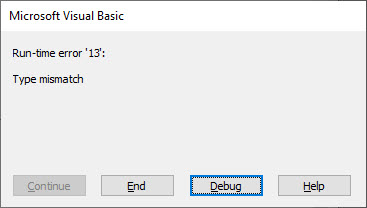

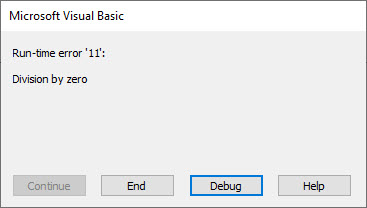
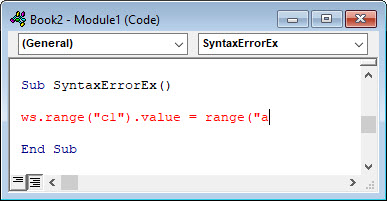
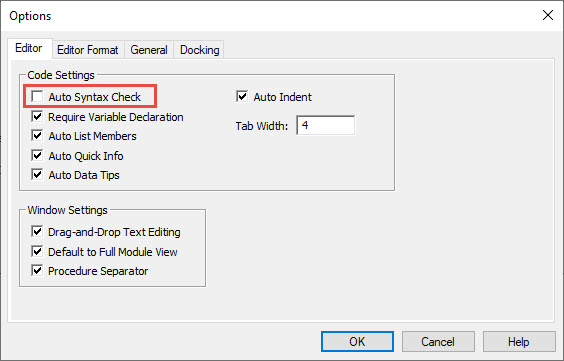
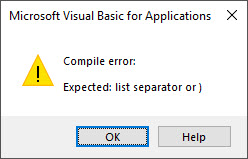

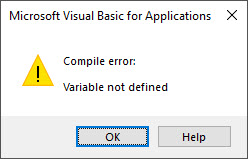

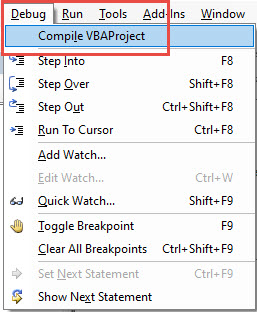
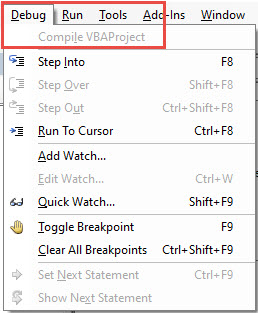
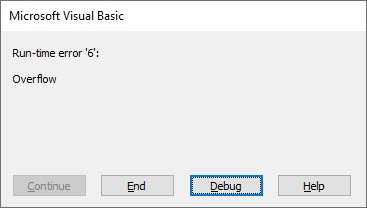

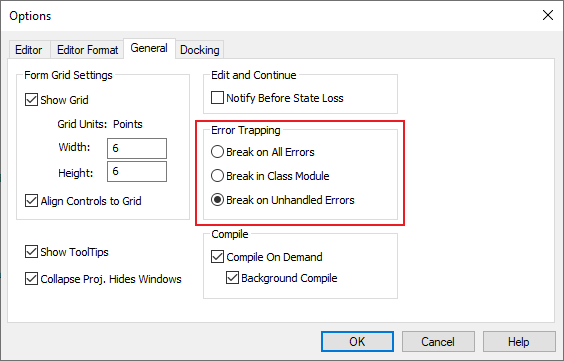
 вооот , там даже шанса не было
вооот , там даже шанса не было 